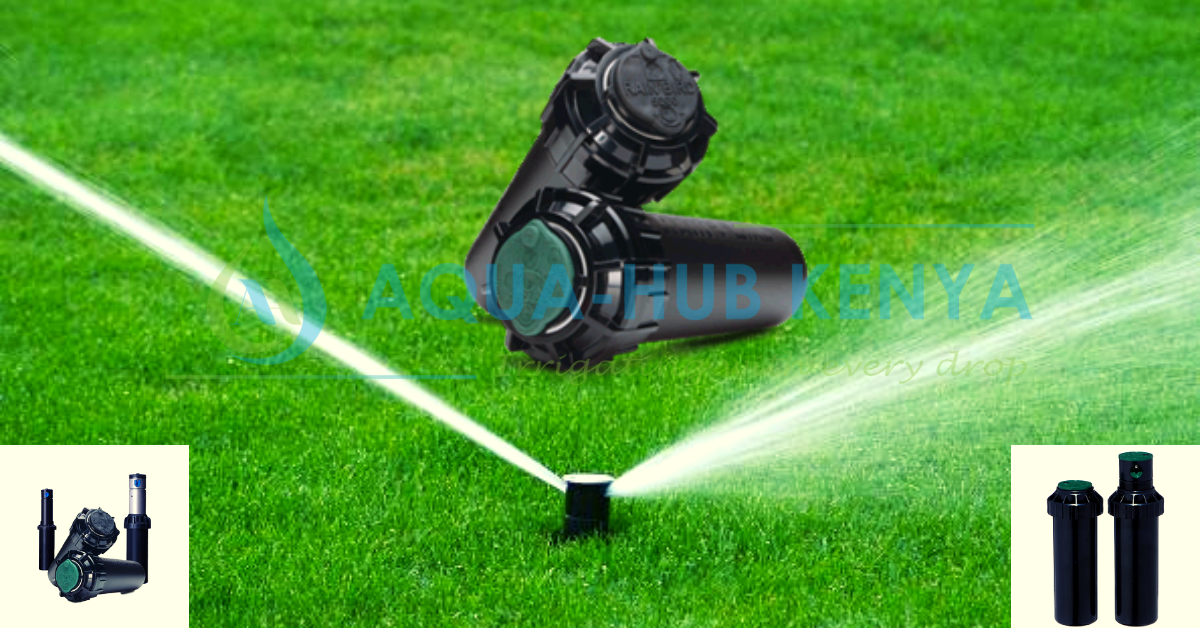Aqua Hub provides the best and most affordable Pop-up Sprinklers in Kenya. Pop-up sprinklers are an irrigation system commonly applicable in landscaping and agriculture. In Kenya, pop-up sprinklers water plants, grass, and crops. They are designed to be placed in the ground. They have a mechanism that allows them to “pop up” and spray water upon activation of the irrigation system. Pop-up sprinklers are popular in Kenya because they are relatively easy to install. They also maintain and can water large areas efficiently. They are also relatively inexpensive when you compare them to other types of irrigation systems.
Pop-up sprinklers typically use a system of pipes and valves to deliver water to the sprinkler heads. Which are placed at regular intervals around the irrigation area. The water is usually delivered from a central point, such as a well or a water tank. Then the distribution is through the pipes to the sprinkler heads using a pump. The pop-up sprinklers can be activated manually or by an automatic timer, allowing precise control of the irrigation schedule. Overall, pop-up sprinklers are a useful and practical tool for watering plants and crops in Kenya. They are widely used in residential and commercial settings. And can help to ensure that plants receive the water they need to thrive.
What are the components of a pop-up sprinkler?
A pop-up sprinkler system typically consists of the following components:
- Sprinkler heads: These are the parts of the system that release the water. Pop-up sprinklers have heads mounted on top of small tubes that rise from the ground when the system is activated. The heads are available in various designs, including rotary, impact, and spray types. You can choose based on the watering needs of the area being irrigated.
- Pipes and valves: The pipes and valves comprise the plumbing system that transports water from the main water supply to the sprinkler heads. In a pop-up sprinkler system, the pipes are usually buried underground. They are connected to the sprinkler heads through a series of valves.
- Control panel: The control panel is the central hub of the pop-up sprinkler system. It is usually located in a central location and is used to activate and deactivate the system and adjust the watering schedule and other system settings.
- Timer or irrigation controller: A timer or irrigation controller is an optional component that can be added to a pop-up sprinkler system to automate the watering process. These devices allow you to set a specific watering schedule so the system will turn on and off at predetermined times.
- Backflow preventer: A backflow preventer is a safety device installed in the plumbing system to prevent water from flowing back into the main water supply. This is particularly important in areas where the water supply may be contaminated or where the water pressure is very high.
- Drainage system: In some cases, a pop-up sprinkler system may also include a drainage system to prevent excess water from accumulating on the soil’s surface. This can help to prevent erosion and protect the plants from being overwatered.
Pop-up sprinkler head spray patterns.
Pop-up sprinkler heads are available in a range of spray patterns designed to suit different types of irrigation applications. Some common spray patterns for pop-up sprinkler heads include:
- Rotary: Rotary sprinkler heads release water spray in a circular pattern. They are typically used for watering large areas, such as lawns, and are often equipped with adjustable nozzles to allow you to control the size and shape of the spray.
- Impact: Impact sprinkler heads release a single stream of water propelled through the air by a small hammer inside the head. These sprinklers are often used for watering gardens or areas with plants that require more water.
- Spray: Spray sprinkler heads release a comprehensive, misty water spray covering a large area. These sprinklers are often used for watering lawns or areas with plants that have shallow roots.
It’s essential to choose the correct spray pattern for your irrigation needs. For example, a rotary sprinkler head with a wide spray pattern may be the most effective option if you have a large lawn. On the other hand, a drip sprinkler head may be a better choice if you have a small garden with plants requiring more water.




